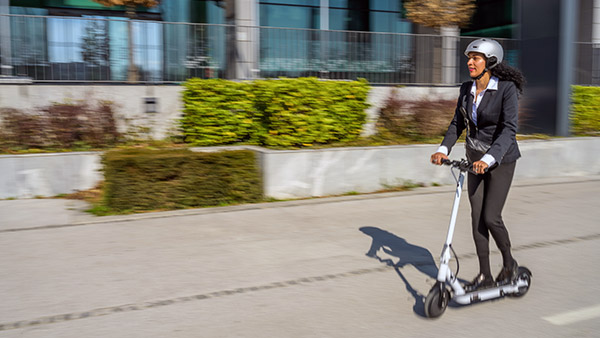
Minimize the risk of head injuries by wearing a helmet.
With more than 65,000 on American streets, electric scooters are every bit as much a part of our transportation landscape as delivery trucks or rideshare cars. E-scooters are a cost-efficient and convenient mode of transportation, but do users collectively understand the risks of riding them?
A study by the University of California, Los Angeles several years ago examined emergency room admission data involving e-scooter injuries and found:
- 5% of the time users were wearing helmets, and 32% of all admissions had some type of head-related injury
- 40% of all admissions involved fractures
In the fall of 2020, the Consumer Product Safety Commission examined e-scooter injury trends in several hundred hospitals nationally and found:
- More than 133,000 emergency room visits from 2017-2019 involved scooters, hoverboards and e-bikes.
- 58% of all injuries involving e-scooters were to users 25 and older.
- Fractures were the most common injuries followed by contusions and abrasions.
- The most frequently injured body parts were upper and lower limbs followed by the head and neck.
- Most injuries, often serious, were related to falls: loss of control, collision with objects and pavement irregularities.
The good news is you can minimize your risk of injury when riding an electric scooter.
BEFORE STARTING
If you follow only one recommendation, make it this one: Always wear a helmet.
- Inspect the brakes; know how long it takes you to stop and be sure to add braking distance in rainy or inclement weather
- Check the tires for flats, nails or low pressure. Because the tires are so small and close to the ground, the effect and consequences of them contacting debris or objects on the pavement is magnified
- Read and understand all manufacturer labels and safety instructions
- Follow the manufacturer’s recommended charging time; overcharging has been associated with overheating and fires
- Be visible. Scooters are often difficult to see, so wear brightly colored clothing or reflective gear as needed
WHILE RIDING
Don’t assume others will see you.
- Adopt a mindset of defensive driving; think of the scooter as a vehicle and not a toy
- Stay sober. Do not operate under the influence of drugs or alcohol
- Ride one person per scooter because additional riders interfere with your balance and greatly increase the risk of collisions
- Eliminate distractions; don’t use headphones, so you can stay aware of your surroundings
- Ride on streets, not sidewalks; check local regulations for use on bike paths
- Follow all traffic laws
- Beware of obstacles in the streets as small potholes and debris can easily cause a fall
- Ride normally. Do not perform stunts or jumps that could damage the scooter as they aren’t designed for the stress of stunts that could interfere with their balance
- Slow down when driving downhill; understand the scooter can pick up speed quickly
Following these tips will help get you where you want to go and, most importantly, get you there safely.
MORE INFORMATION
“Injuries Associated with Standing Electric Scooter Use” (2020), National Library of Medicine, National Center for Biotechnology Information
“Electric Scooter Injuries are on the Rise: CPSC Releases New Study” (2020), U.S. Consumer Product Safety Commission
This loss control information is advisory only. The authors assume no responsibility for management or control of loss control activities. Not all exposures are identified in this article. Contact your local, independent insurance agent for coverage advice and policy service.
